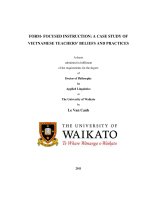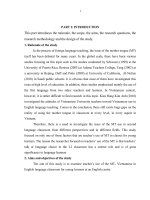Case Study: republic of koreas green credit card
Bạn đang xem bản rút gọn của tài liệu. Xem và tải ngay bản đầy đủ của tài liệu tại đây (222.07 KB, 3 trang )
Low Carbon Green Growth Roadmap for Asia and the Pacific
CASE STUDY
Charging ahead into green lifestyles
Republic of Korea’s green credit card
Key point
•
Linking low-carbon lifestyles with a mainstream incentive system, such as credit cards, engages
consumers towards more sustainable consumption patterns, in turn greening the supply chain.
There was a need…
The Korean Ministry of Environment introduced a green credit card scheme in July 2011 to encourage consumers
to adopt more sustainable lifestyle patterns by providing tangible economic rewards. Points are accumulated
as rewards for saving on utility use (tap water, electricity and gas heating), using public transport or purchasing
eco-friendly products. Accumulated points can be used like cash to purchase products and services at a variety
of places, such as hotels, restaurants and theatres. Points can also be used to buy eco-friendly products, such as
hybrid cars or energy-efficient light bulbs. The scheme is envisaged to contribute towards reducing about 3 per
cent of the annual CO2 emissions from the residential sector by 2014 when the number of cardholders is
expected to exceed 3 million.1
What was done?
Carbon points generated from saving energy in residential and commercial building sectors
A carbon point scheme, based on the amount of saved electricity, gas and tap water in the building sector, was
incorporated into the green credit card scheme. The carbon point scheme was initially introduced by the Ministry of Environment in 2008 and operated by municipal governments, with technical support from the Korea Environment Corporation. Both the Ministry of Environment and the municipal governments are responsible for mobilizing the financial resources that are granted as carbon points. Households can acquire points if their monthly
utilities usage is less than their average use in the two years prior to the application date.
Green purchasing points
Green points can be obtained whenever people purchase green products, certified with eco-labels, such as
Korea Eco-Label and Carbon Label, via the green credit card. The Ministry of Environment signed a memorandum of understanding with 49 private companies (18 manufacturers,2 8 distributors and retailers, 2 franchised
coffee shops and 16 affiliated shops) in January 2012.3 Points are also acquired when people bring their own
cups to the coffee shop and return used cellular phones to providers. Manufacturers and distributors engaging
in this scheme are partly responsible for providing the financial resources that flow into the green purchasing
points.
Public transport point
Paying public transport fares with a credit card is common in the Republic of Korea and is widely accepted by
different modes of public transport (bus, express bus, mini bus, subway and taxis). Fare discounts are provided
when people transfer from one mode of public transport to another. The credit card companies provide points
to passengers engaging in this scheme. Thus green points can amplify the “pull-factor” for using public transport.
1
Republic of Korea, Green Growth in Daily Lives (Seoul, Presidential Committee on Green Growth, 2011).
2
Including Hyundai automobile company and LG electronic appliances.
3
Korea Environmental Industry & Technology Institute, Green Consumption (Seoul, 2011). Available from
www.greencard.or.kr/gc/benefit/consu mption.do (accessed 30 January 2012).
Low Carbon Green Growth Roadmap for Asia and the Pacific : Case Study - Republic of Korea’s green credit card
Institutional arrangement4
•
•
•
The Ministry of Environment is in charge of setting up an overarching system and coordinating partner
organizations (local governments, the Korea Environmental Industry and Technology Institute (KEITI) and
credit card companies).
Local governments are in charge of operating the carbon point scheme and coordinating utilities
companies with financial support from the Ministry of Environment. For instance, carbon points are issued
according to the amount of energy that is reduced from a baseline assessment. Data for energy, water
and gas use is collected to set the baseline in cooperation with the utilities companies, such as Korea
Electric Power Corporation and the Korea Gas Safety Corporation. The Korea Environment Corporation
collects data from utility companies, calculates the amount of reduced consumption and reports it to
the local government, which then authorizes the payment of points.
The Korea Environmental Industry and Technology Institute is in charge of managing the green
purchasing points, namely identifying eco-friendly manufacturers, establishing a partnership with them
and managing the eco-labelling scheme.
Strengths of the scheme
•
•
•
•
•
Green credit card points can be more widely used due to use of the network built up by credit card
companies in comparison to the stand-alone incentive schemes, such as carbon points, that local
governments manage. Featuring minimal implementing costs, this can be a cost-effective policy
measure to induce behaviour changes towards low-carbon and greener lifestyles.
It is easy and convenient for people to manage points generated from different sectors (building,
transport, purchasing) via one handy credit card.
By motivating consumers towards greener lifestyles, the whole supply chains for products and services
becomes greener to meet the new demand for eco-friendly products.
Encouraged by the additional economic incentives, more people rely on public transportation.
The incentives lead to reduced CO2 emissions in the building sector.
Weaknesses of the scheme
•
•
The more people purchase or move about, the more rewards they receive – but this does not provide
any incentive for consuming less or reducing travel.
Carbon points are issued based on the relative amount of saved energy from a baseline assessment,
without the consideration of the absolute amount of energy use. Thus the green credit card scheme may
need to be combined with other policy measures to increase effectiveness.
Lessons learned
Low-carbon behaviours need to be visible. Users of the green credit card scheme can easily track the amount
of their CO2 emission reduction, energy savings and economic rewards related to lifestyle changes they make
through:
•
•
4
The eco mileage scheme, one of the carbon point schemes run by the Seoul municipal authority, which
provides information through its website ( Card users can access
real-time data on the volume of energy consumption from their house from the site. By inputting basic
information, such as name and address, into the Eco-Mileage Programme website, the amount of
energy, gas and water consumption is automatically presented.
Receipts with the detailed information encourage green purchasing by informing consumers how many
points each purchase provides.
Republic of Korea, Launching Green Credit Card (Seoul, Ministry of Environment, 2011).
Low Carbon Green Growth Roadmap for Asia and the Pacific : Case Study - Republic of Korea’s green credit card
Considerations for replicating
The private sector must be engaged. To be successful, points should be easily convertible into real monetary
value at a variety of places. Otherwise, consumers will not be motivated enough to change their behaviour to
acquire the points. It is important for governments to set up a network consisting of credit card companies,
manufacturers, distributors and retailers that can expand the scope of the scheme and maximize the net
impacts. Participating businesses are expected to commit a certain portion of their profit to finance the point
scheme, which can be a financial burden for them. In the case of the Republic of Korea, policies supplemented
the green credit card scheme, such as the one providing subsidies to stores specializing in green products.
Existing incentive schemes must be integrated. The green credit card scheme is expected to be an integrated
single platform in which people manage the points generated from their efforts to mitigate greenhouse gas
emissions in their daily lives. The Ministry of Knowledge and Economy offers a similar incentive programme called
Carbon Cashbag, which provides points in addition to the existing points system run by a private company when
people purchase eco-friendly products bearing the Carbon Cashbag labels. Without careful coordination of
similar initiatives, the strength of the scheme would be offset and financial resources would be wasted due to an
inefficiency-inducing overlap of services, provided by different ministries.
Simple design and effective communication – an incentive scheme has to be easy to understand and simple to
follow. The credit card scheme should be easily understandable and retractable for ordinary users. The rewards
need to be clearly communicated to consumers to minimize potential confusion with any existing incentive
scheme. Timely updates, accurate and reliable information provided on the respective websites is also critical.
For instance, a dedicated website for the green credit card (www.greencard.or.kr) is currently being operated
to publicize the benefits as well as to provide guidelines on how to register.









